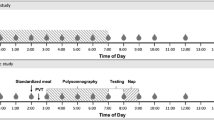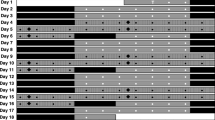Abstract
Pharmacokinetic and pharmacodynamic responses to caffeine (2.5 mg/kg) were compared between ten healthy self-rated poor sleepers and ten normal sleepers. Sleep pattern assessed by the Pittsburgh Sleep Quality Index (PSQI). There was no significant difference in mean estimated daily caffeine consumption between the groups. The poor sleepers had significantly higher scores for neuroticism on the Eysenck Personality Questionnaire (EPQ) and anxiety on the Hospital Anxiety Depression (HAD) scale, compared with normal sleepers. Caffeine pharmacokinetics were assessed by measurement of saliva caffeine concentrations. Poor sleepers showed significantly greater variability in caffeine Cmax, clearance and half-life, compared to normal sleepers. Pharmacodynamic measures included heart rate, blood pressure, visual analogue scales for concentration, vigilance and relaxation, psychomotor performance [Digit Symbol Substitution Test (DSST) and tapping rate (TR)] and EEG activity [Contingent negative variation (CNV), auditory evoked potential and power spectral analysis]. Prior to caffeine administration, poor sleepers compared to normal sleepers had faster heart rates, lower ratings for concentration and relaxation, poorer performance on the DSST, greater CNV magnitude, faster peak alpha frequency and lower delta, theta and beta power. These differences persisted after caffeine ingestion and overall differences between the groups on these measures were significant (P<0.01–0.001). Post-dose, but not pre-dose, scores for vigilance and TR were significantly lower overall in poor compared with normal sleepers. Despite the baseline differences between poor and normal sleepers, the changes following caffeine administration were similar in direction and magnitude in both groups.
Similar content being viewed by others
References
Badcock NR (1990) Simpler measurement of caffeine and paraxanthine in saliva. Clin Chem 36:391
Balter MB, Uhlenuth EH (1992) New epidemiological findings about insomnia and its treatment. J Clin Psychiatry 53:34–42
Barone JJ, Roberts H (1984) Human consumption of caffeine. In: Dews PB (ed) Caffeine: perspectives for recent research. Springer, Berlin, pp 59–73
Berman SR, Buysse DJ, Kupfer DJ, Monk TH, Reynolds CF (1988) The Pittsburgh sleep quality index: a new instrument for psychiatric practice and research. Psychiatry Res 28:193–213
Boulenger J-P, Uhde T (1982) Caffeine consumption and anxiety: preliminary results of a survey comparing patients with anxiety disorders and normal controls. Psychopharmacol Bull 18:53–57
Boulenger J-P, Uhde TW, Wolff A, Post RM (1984) Increased sensitivity to caffeine in patients with panic disorders. Arch Gen Psychiatry 41:1067–1071
Bruce M, Scott N, Shire P, Lader M (1992) Anxiogenic effects of caffeine in patients with anxiety disorders. Arch Gen Psychiatry 49:867–869
Carskadon MA, Roth T (1991) Sleep restriction. In: Mont TH (ed) Sleep, sleepiness and performance. Wiley, New York, pp 155–167
Charney DS, Heninger GR, Jatlow PI (1985) Increased anxiogenic effects of caffeine in panic disorder. Arch Gen Psychiatry 42:233–243
Cooper R, Osselton JW, Shaw JC (1980) EEG technology, 3rd edn. Butterworth, London
Dorsey CM (1991) Failing to sleep: psychological and behavioural underpinning of insomnia. In: Mont TH (ed) Sleep, sleepiness and performance. Wiley, New York, pp 223–247
Dorsey C, Bootzin RS (1987) Subjective and psychophysiologic insomnia: multiple sleep latency test, sleep latency and personality. Sleep Res 16:328
Eysenck HJ, Eysenck SBG (1975) Eysencl personality questionnaire. Hodder & Stoughton, London
Fink M (1978) Psychoactive drugs and the waking EEG. In: Lipton MA, DiMascio A, Killam KF (eds) Psychopharmacology: a generation of progress. Raven Press, New York, pp 691–698
Freedman RR, Sattler HL (1982) Physiological and psychological factors in sleep-onset insomnia. J Abnorm Psychol 91:380–389
Fuhr V, Rost KL (1994) Simple and reliable CYP1A2 phenotyping by the paraxanthine/caffeine ratio in plasma and saliva. Pharmacogenetics 4:109–116
Goldstein A, Kaizer S (1969) Psychotropic effects of caffeine in man. III A questionnaire survey of coffee drinking and effects on a group of housewives. Clin Pharmacol Ther 10:477–488
Grant DM, Tang BK, Kalow W (1983) Variability in caffeine metabolism. J Clin Pharmacol Ther 33:591–602
Greden JF (1974) Anxiety or caffeinism: a diagnostic dilemma. Am J Psychiatry 131:1089–1092
Haynes SN, Adams A, Franzen M (1981) The effects of presleep stress on sleep-onset insomnia. J Abnorm Psychol 90:601–606
Horne JA (1991) Dimensions to sleepiness. In: Mont TH (ed) Sleep, sleepiness and performance. Wiley, New York, pp 169–196
James JE (1991) Caffeine and health. Academic Press, London
James JE, Crosbie J (1987) Somatic and psychological implications of heavy caffeine use. Br J Addict 82:503–509
Kales A, Caldwell AB, Soldatos CR, Bixler EO, Kales JD (1983) Biopsychobehavioural correlates of insomnia. II. Pattern specificity and consistency with the Minnesota multiphasic personality inventory. Psychosom Med 45:341–356
Lader MH, Bruce MS (1989) The human pharmacology of the methylxanthines. In: Hindmarsh I, Storier PD (eds) Human psychopharmacology: measures and methods, vol. 2. Wiley London, pp 179–200
Levin D, Bertelson AD, Lacks P (1984) MMPI differences among mild and severe insomniacs and good sleepers. J Person Assess 48:126–129
Levy M, Zylber-Katz E (1983) Caffeine metabolism and coffee-attributed sleep disturbances. Clin Pharmacol Ther 33:770–774
Matthews JNS, Altman DG, Campbell MJ, Royston P (1990) Analysis of serial measurements in medical research. BMJ 300:230–235
Monroe LJ (1967) Psychological and physiological differences between good and poor sleepers. J Abnorm Psychol 72:255–264
Morgan K, Dallasso H, Ebrahim S, Arie T, Pentem PH (1988) Characteristics of subjective insomnia in the elderly living at home. Age Aging 17:1–7
Morgan K, Healey DW, Healey PJ (1989) Factors influencing persistent subjective insomnia in old age: a follow-up study of good and poor sleepers aged 65 to 74. Age Ageing 18:117–122
National Institute of Mental Health (1984) Consensus conference report: drugs and insomnia: the use of medication to promote sleep. JAMA 251:2410–2414
Nino-Murcia C (1992) Diagnosis and treatment of insomnia and risks associated with lack of treatment. J Clin Psychiatry 53 [12 (Suppl)]:43–49
Pritchard WS (1981) Psychophysiology of P300. Psychol Bull 89:506–540
Shagass C, Straumenis JJ (1978) Drugs and human sensory evoked potentials. In: Lipton MA, DiMascio A, Killam KF (eds) Psychopharmacology: a Generation of Progress. Raven Press, New York, pp 699–709
Tecce JJ, Cole JO (1976) The distreaction-arousal hypothesis, CNV, and schizophrenia. In: Mostofsky DI (ed) Behaviour control and modification of physiological activity. Prentice-Hall, Englewood Cliffs, N.J., pp 162–219
Walter WG, Cooper R, Aldridge VJ, McCallum, WC, Winter AL (1964) Contingent negative variation: and electric sign of sensorimotor association and expectancy in the human brain. Nature 203:380–384
Welstein L, Dement WC, Redington D, Guilleminault C (1983) Insomnia in the San Francisco Bay area: a telephone survey. In: Guillemault C, Lugaresi E (eds) Sleep/Wake Disorders: Natural History, Epidemiology, and Long-term Evolution. Raven Press, New York
Zigmond AS, Snaith RP (1983) The hospital anxiety and depression (HAD) scale. Acta Psychiatr Scand 67:361–370
Author information
Authors and Affiliations
Rights and permissions
About this article
Cite this article
Tiffin, P., Ashton, H., Marsh, R. et al. Pharmacokinetic and pharmacodynamic responses to caffeine in poor and normal sleepers. Psychopharmacology 121, 494–502 (1995). https://doi.org/10.1007/BF02246500
Received:
Revised:
Issue Date:
DOI: https://doi.org/10.1007/BF02246500




